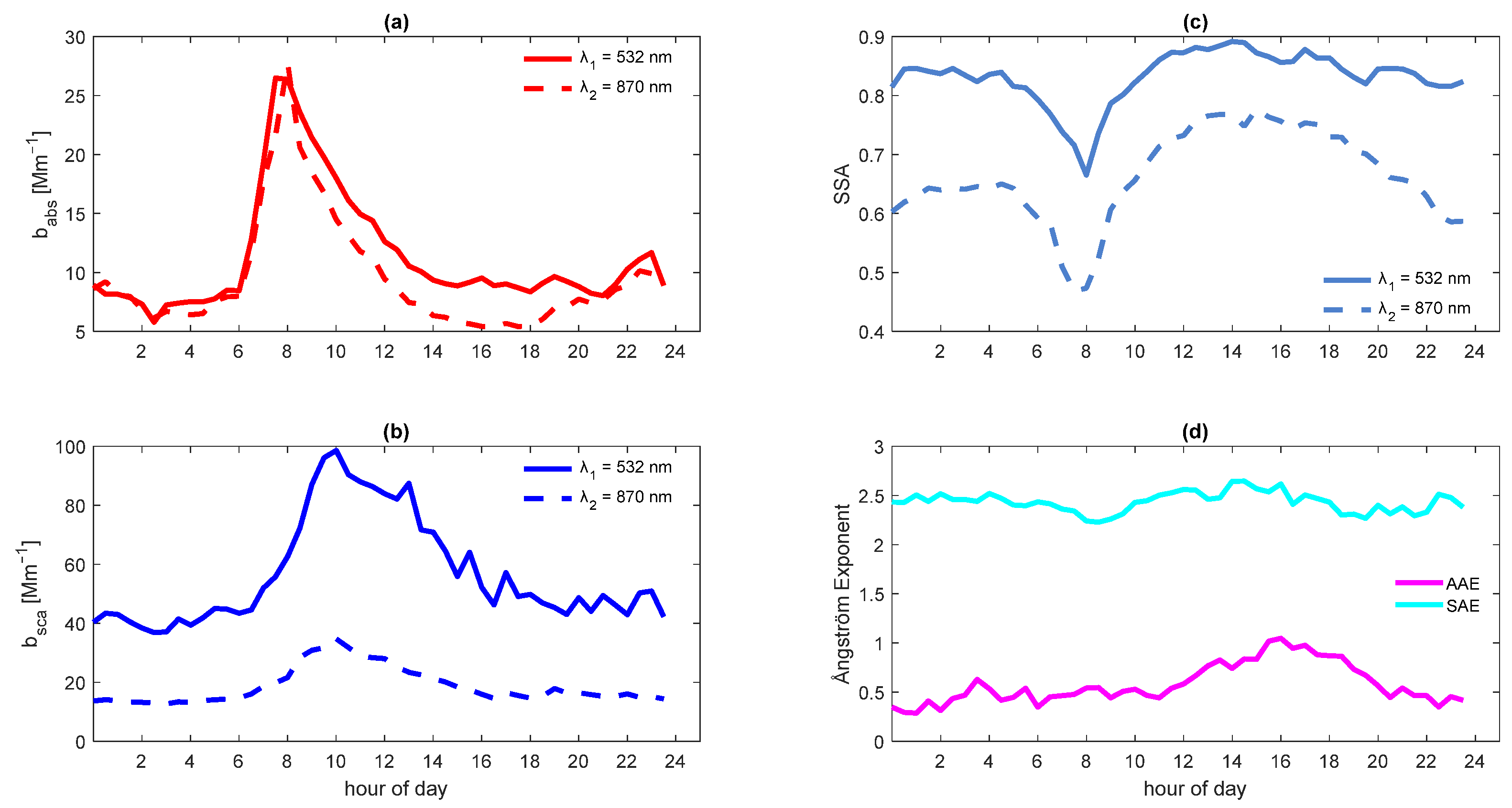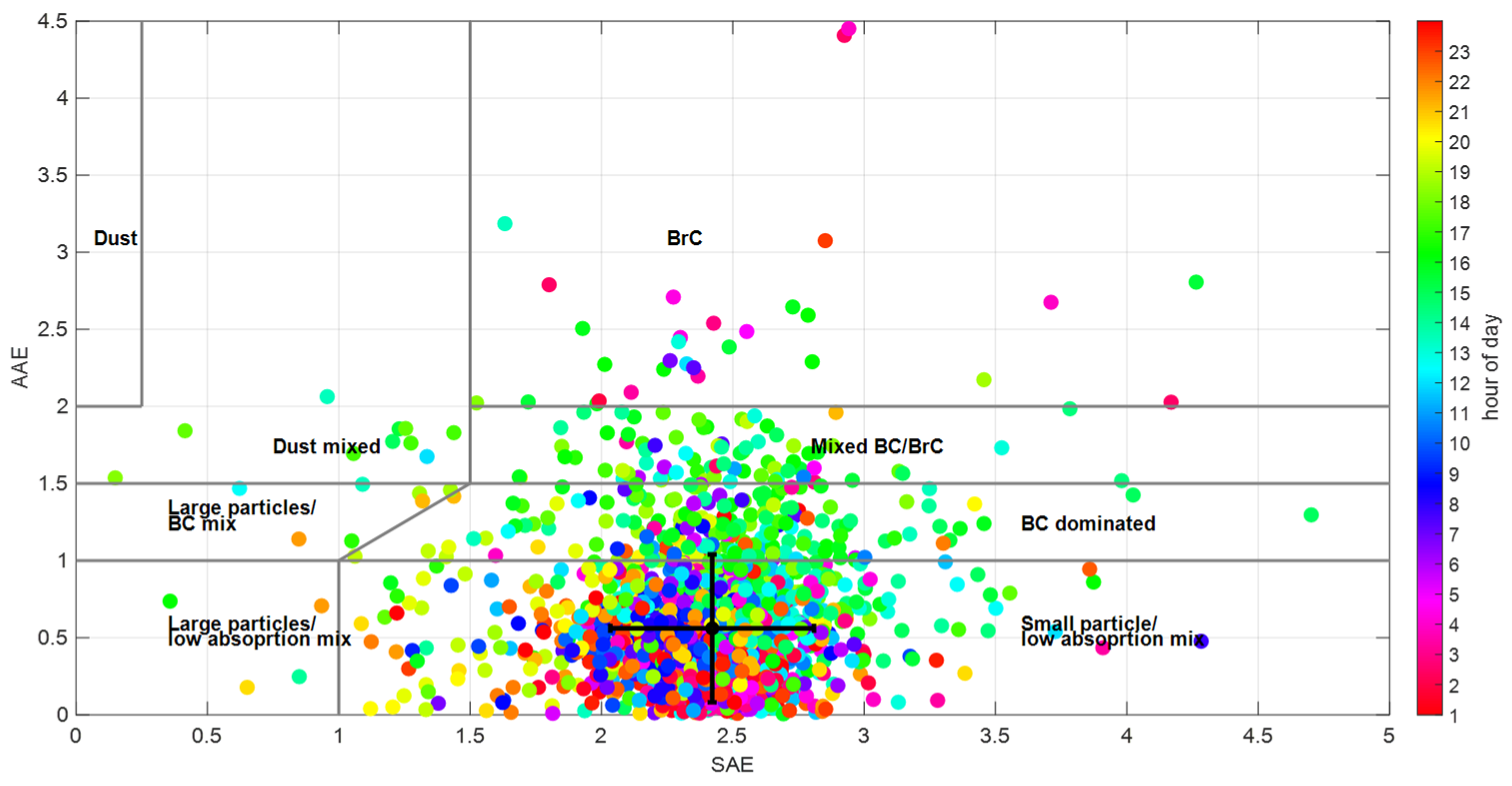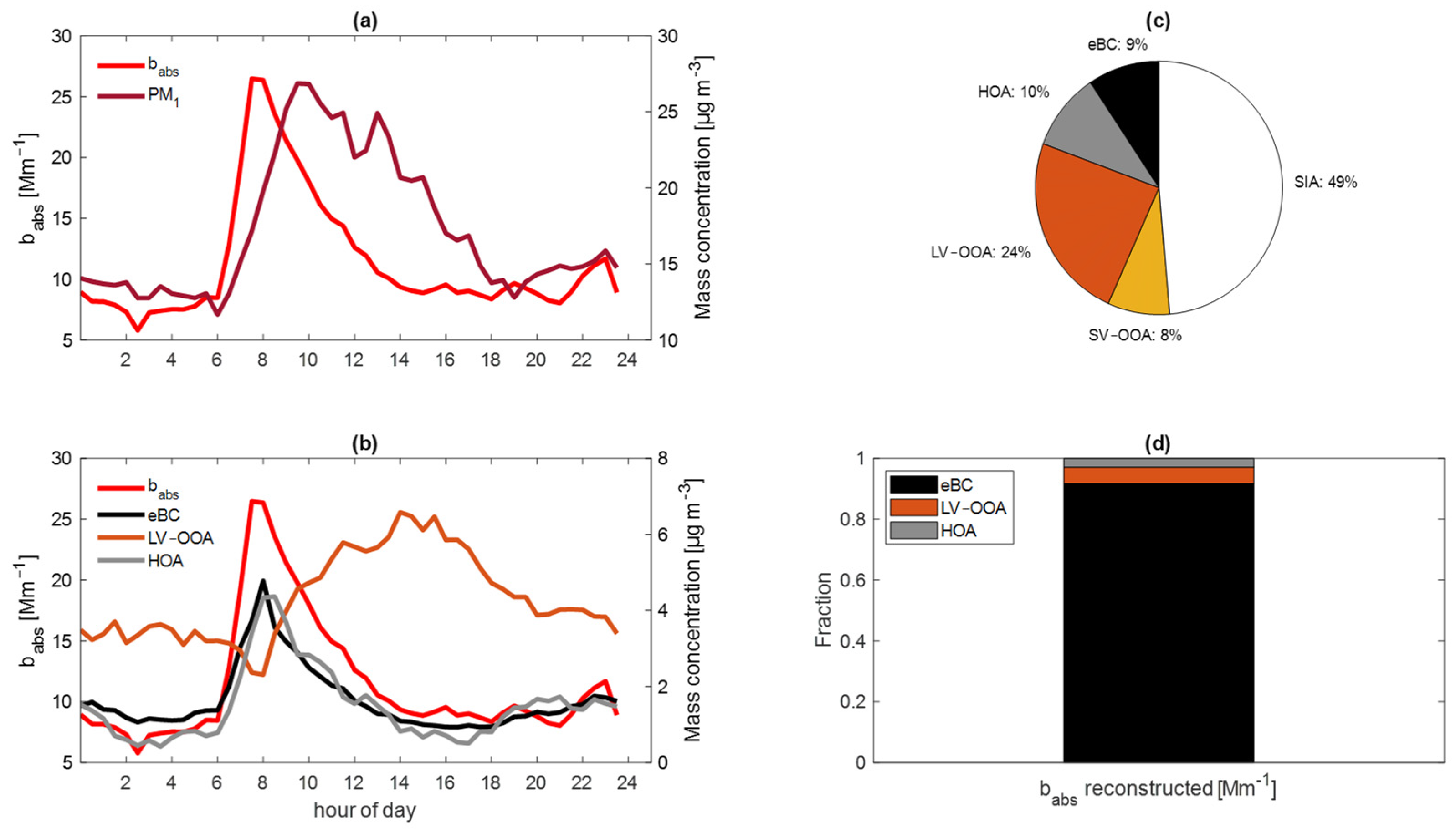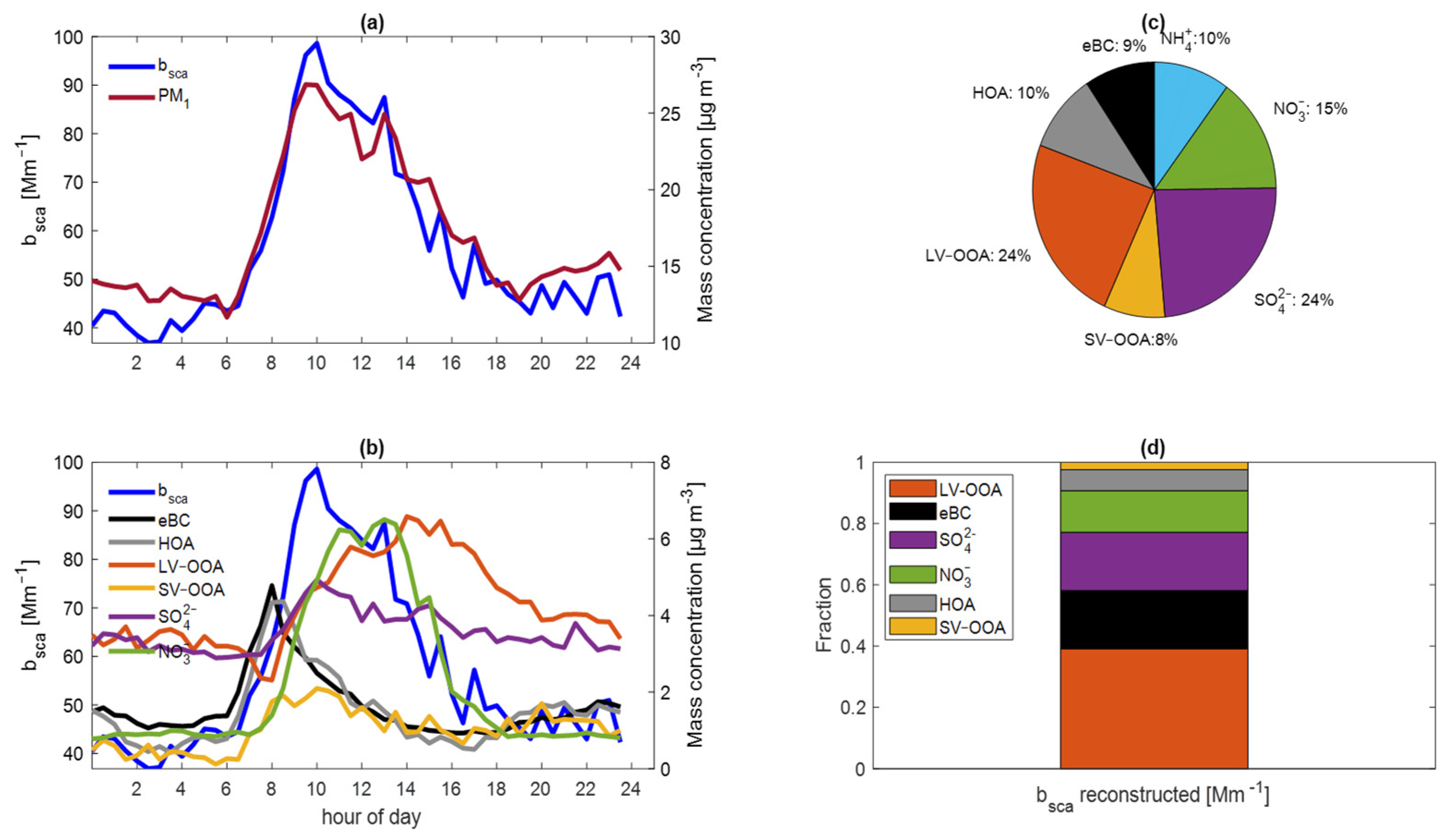Mass Absorption Efficiency of PM1 in Mexico City during ACU15
Abstract
:1. Introduction
2. Materials and Methods
2.1. Aerosol Chemical Speciation
2.2. Particle Optical Properties
2.3. Multiple Linear Regression
3. Results
3.1. Aerosol Chemical Speciation
3.2. Particle Optical Properties
3.3. Mass Absorption Efficiency
3.4. Mass Scattering Efficiency
4. Discussion
5. Conclusions
Author Contributions
Funding
Institutional Review Board Statement
Informed Consent Statement
Data Availability Statement
Acknowledgments
Conflicts of Interest
References
- Horvath, H. Estimation of the average visibility in central Europe. Atmos. Environ. 1995, 29, 241–246. [Google Scholar] [CrossRef]
- Boucher, O. Atmospheric Aerosols; Springer: Dordrecht, The Netherlands, 2015. [Google Scholar]
- Ren, R.; Li, Z.; Yan, P.; Wang, Y.; Wu, H.; Cribb, M.; Wang, W.; Jin, X.; Li, Y.; Zhang, D. Measurement report: The effect of aerosol chemical composition on light scattering due to the hygroscopic swelling effect. Atmos. Chem. Phys. 2021, 21, 9977–9994. [Google Scholar] [CrossRef]
- World Health Organization European Centre for Environment. WHO Global Air Quality Guidelines: Particulate Matter (PM2.5 and PM10), Ozone, Nitrogen Dioxide, Sulfur Dioxide and Carbon Monoxide; World Health Organization, Ed.; WHO: Bonn, Germany, 2021. [Google Scholar]
- Watson, J.G. Visibility: Science and Regulation. J. Air Waste Manag. Assoc. 2002, 52, 628–713. [Google Scholar] [CrossRef] [PubMed] [Green Version]
- Hand, J.L.; Malm, W.C. Review of aerosol mass scattering efficiencies from ground-based measurements since 1990. J. Geophys. Res. Earth Surf. 2007, 112, 008484. [Google Scholar] [CrossRef]
- Deng, J.; Zhang, Y.; Hong, Y.; Xu, L.; Chen, Y.; Du, W.; Chen, J. Optical properties of PM2.5 and the impacts of chemical compositions in the coastal city Xiamen in China. Sci. Total Environ. 2016, 557–558, 665–675. [Google Scholar] [CrossRef]
- Fu, X.; Wang, X.; Hu, Q.; Li, G.; Ding, X.; Zhang, Y.; He, Q.; Liu, T.; Zhang, Z.; Yu, Q.; et al. Changes in visibility with PM2.5 composition and relative humidity at a background site in the Pearl River Delta region. J. Environ. Sci. 2016, 40, 10–19. [Google Scholar] [CrossRef]
- Ma, Q.; Wu, Y.; Fu, S.; Zhang, D.; Han, Z.; Zhang, R. Pollution severity-dependent aerosol light scattering enhanced by inorganic species formation in Beijing haze. Sci. Total Environ. 2020, 719, 137545. [Google Scholar] [CrossRef]
- Szopa, S.; Naik, V.; Adhikary, B.; Artaxo, P.; Berntsen, T.; Collins, W.D.; Fuzzi, S.; Gallardo, L.; Klimont, Z.; Liao, H.; et al. Chapter 6: Short-Lived Climate Forcers. In Climate Change 2021: The Physical Science Basis. Contribution of Working Group I to the Sixth Assessment Report of the Intergovernmental Panel on Climate Change; Cambridge University Press: Cambridge, UK; New York, NY, USA, 2021; pp. 817–992. [Google Scholar] [CrossRef]
- Chow, J.C.; Watson, J.G.; Lowenthal, D.H.; Richards, L.W. Comparability between PM2.5 and particle light scattering measurements. Environ. Monit. Assess. 2002, 79, 29–45. [Google Scholar] [CrossRef]
- Querol, X.; Pey, J.; Minguillón, M.C.; Pérez, N.; Alastuey, A.; Viana, M.; Moreno, T.; Bernabé, R.M.; Blanco, S.; Cárdenas, B.; et al. PM speciation and sources in Mexico during the MILAGRO-2006 Campaign. Atmos. Chem. Phys. 2008, 8, 111–128. [Google Scholar] [CrossRef]
- Mugica, V.; Ortiz, E.; Molina, L.; De Vizcaya-Ruiz, A.; Nebot, A.; Quintana, R.; Aguilar, J.; Alcántara, E. PM composition and source reconciliation in Mexico City. Atmos. Environ. 2009, 43, 5068–5074. [Google Scholar] [CrossRef]
- Vega, E.; Ruiz, H.; Escalona, S.; Cervantes, A.; Lopez–Veneroni, D.; Gonzalez–Avalos, E.; Sanchez–Reyna, G. Chemical composition of fine particles in Mexico City during 2003–2004. Atmos. Pollut. Res. 2011, 2, 477–483. [Google Scholar] [CrossRef]
- Carabali, G.; Mamani-Paco, R.; Castro, T.; Peralta, O.; Herrera, E.; Trujillo, B. Optical properties, morphology and elemental composition of atmospheric particles at T1 supersite on MILAGRO campaign. Atmos. Chem. Phys. 2012, 12, 2747–2755. [Google Scholar] [CrossRef] [Green Version]
- Kirchstetter, T.W.; Novakov, T.; Hobbs, P.V. Evidence that the spectral dependence of light absorption by aerosols is affected by organic carbon. J. Geophys. Res. Atmos. 2004, 109, 004999. [Google Scholar] [CrossRef] [Green Version]
- Knox, A.; Evans, G.J.; Brook, J.R.; Yao, X.; Jeong, C.-H.; Godri, K.J.; Sabaliauskas, K.; Slowik, J.G. Mass Absorption Cross-Section of Ambient Black Carbon Aerosol in Relation to Chemical Age. Aerosol Sci. Technol. 2009, 43, 522–532. [Google Scholar] [CrossRef]
- Bond, T.C.; Doherty, S.J.; Fahey, D.W.; Forster, P.M.; Berntsen, T.; DeAngelo, B.J.; Flanner, M.G.; Ghan, S.; Kärcher, B.; Koch, D.; et al. Bounding the role of black carbon in the climate system: A scientific assessment. J. Geophys. Res. Atmos. 2013, 118, 5380–5552. [Google Scholar] [CrossRef]
- Guan, X.; Wang, M.; Du, T.; Tian, P.; Zhang, N.; Shi, J.; Chang, Y.; Zhang, L.; Zhang, M.; Song, X.; et al. Wintertime aerosol optical properties in Lanzhou, Northwest China: Emphasis on the rapid increase of aerosol absorption under high particulate pollution. Atmos. Environ. 2020, 246, 118081. [Google Scholar] [CrossRef]
- Aiken, A.C.; Salcedo, D.; Cubison, M.J.; Huffman, J.A.; Decarlo, P.F.; Ulbrich, I.M.; Docherty, K.S.; Sueper, D.; Kimmel, J.R.; Worsnop, D.R.; et al. Mexico City Aerosol Analysis during MILAGRO Using High Resolution Aerosol Mass Spec-trometry at the Urban Supersite (T0)-Part 1: Fine Particle Composition and Organic Source Apportionment. Atmos. Chem. Phys. 2009, 9, 6633–6653. [Google Scholar] [CrossRef] [Green Version]
- Holland, G.; Cassidy, M.; Ballentine, C.J. Meteorite Kr in Earth’s Mantle Suggests a Late Accretionary Source for the Atmosphere. Science 2009, 326, 1522–1525. [Google Scholar] [CrossRef]
- Hodzic, A.; Jimenez, J.L. Modeling anthropogenically controlled secondary organic aerosols in a megacity: A simplified framework for global and climate models. Geosci. Model Dev. 2011, 4, 901–917. [Google Scholar] [CrossRef]
- Gyawali, M.; Arnott, W.P.; Lewis, K.; Moosmüller, H. In situ aerosol optics in Reno, NV, USA during and after the summer 2008 California wildfires and the influence of absorbing and non-absorbing organic coatings on spectral light absorption. Atmos. Chem. Phys. 2009, 9, 8007–8015. [Google Scholar] [CrossRef] [Green Version]
- Bahadur, R.; Praveen, P.S.; Xu, Y.; Ramanathan, V. Solar absorption by elemental and brown carbon determined from spectral observations. Proc. Natl. Acad. Sci. USA 2012, 109, 17366–17371. [Google Scholar] [CrossRef] [PubMed] [Green Version]
- Andreae, M.O.; Gelencsér, A. Black Carbon or Brown Carbon? The Nature of Light-Absorbing Carbonaceous Aerosols. Atmos. Chem. Phys. 2006, 6, 3131–3148. [Google Scholar] [CrossRef] [Green Version]
- Sun, H.; Biedermann, L.; Bond, T.C. Color of brown carbon: A model for ultraviolet and visible light absorption by organic carbon aerosol. Geophys. Res. Lett. 2007, 34, 029797. [Google Scholar] [CrossRef]
- Paredes-Miranda, G.; Arnott, W.P.; Jimenez, J.L.; Aiken, A.C.; Gaffney, J.S.; Marley, N.A. Primary and Secondary Con-tributions to Aerosol Light Scattering and Absorption in Mexico City during the MILAGRO 2006 Campaign. Atmos. Chem. Phys. 2009, 9, 3721–3730. [Google Scholar] [CrossRef] [Green Version]
- Latimer, R.N.C.; Martin, R.V. Interpretation of measured aerosol mass scattering efficiency over North America using a chemical transport model. Atmos. Chem. Phys. 2019, 19, 2635–2653. [Google Scholar] [CrossRef] [Green Version]
- Salcedo, D.; Onasch, T.B.; Dzepina, K.; Canagaratna, M.R.; Zhang, Q.; Huffman, J.A.; DeCarlo, P.F.; Jayne, J.T.; Mortimer, P.; Worsnop, D.R.; et al. Characterization of ambient aerosols in Mexico City during the MCMA-2003 campaign with Aerosol Mass Spectrometry: Results from the CENICA Supersite. Atmos. Chem. Phys. 2006, 6, 925–946. [Google Scholar] [CrossRef] [Green Version]
- Doran, J.C.; Barnard, J.C.; Arnott, W.P.; Cary, R.; Coulter, R.; Fast, J.D.; Kassianov, E.I.; Kleinman, L.; Laulainen, N.S.; Martin, T.; et al. The T1-T2 study: Evolution of aerosol properties downwind of Mexico City. Atmos. Chem. Phys. 2007, 7, 1585–1598. [Google Scholar] [CrossRef] [Green Version]
- Adachi, K.; Buseck, P.R. Internally mixed soot, sulfates, and organic matter in aerosol particles from Mexico City. Atmos. Chem. Phys. 2008, 8, 6469–6481. [Google Scholar] [CrossRef] [Green Version]
- Marley, N.A.; Gaffney, J.S.; Castro, T.; Salcido, A.; Frederick, J. Measurements of aerosol absorption and scattering in the Mexico City Metropolitan Area during the MILAGRO field campaign: A comparison of results from the T0 and T1 sites. Atmos. Chem. Phys. 2009, 9, 189–206. [Google Scholar] [CrossRef]
- Dubovik, O.; Holben, B.; Eck, T.F.; Smirnov, A.; Kaufman, Y.J.; King, M.D.; Tanré, D.; Slutsker, I. Variability of Absorption and Optical Properties of Key Aerosol Types Observed in Worldwide Locations. J. Atmos. Sci. 2002, 59, 590–608. [Google Scholar] [CrossRef]
- Cheng, Z.; Jiang, J.; Chen, C.; Gao, J.; Wang, S.; Watson, J.G.; Wang, H.; Deng, J.; Wang, B.; Zhou, M.; et al. Estimation of Aerosol Mass Scattering Efficiencies under High Mass Loading: Case Study for the Megacity of Shanghai, China. Environ. Sci. Technol. 2014, 49, 831–838. [Google Scholar] [CrossRef] [PubMed]
- Doran, J.C.; Fast, J.D.; Barnard, J.C.; Laskin, A.; Desyaterik, Y.; Gilles, M.K. Applications of lagrangian dispersion modeling to the analysis of changes in the specific absorption of elemental carbon. Atmos. Chem. Phys. 2008, 8, 1377–1389. [Google Scholar] [CrossRef] [Green Version]
- Pavia, R. Eficiencia de Absorción de Masa de Carbono Elemental y Propiedades Ópticas de Partículas Atmosféricas PM2.5. Master’s Thesis, UNAM, Ciudad Universitaria, Ciudad de México, México, 2017. [Google Scholar]
- Gelencsér, A. Carbonaceous Aerosol, 1st ed.; Atmospheric and Oceanographic Sciences Library; Springer: Dordrecht, The Netherlands, 2004; Volume 30. [Google Scholar] [CrossRef]
- Kondo, Y.; Komazaki, Y.; Miyazaki, Y.; Moteki, N.; Takegawa, N.; Kodama, D.; Deguchi, S.; Nogami, M.; Fukuda, M.; Miyakawa, T.; et al. Temporal variations of elemental carbon in Tokyo. J. Geophys. Res. 2006, 111, 006257. [Google Scholar] [CrossRef]
- Zanatta, M.; Gysel, M.; Bukowiecki, N.; Müller, T.; Weingartner, E.; Areskoug, H.; Fiebig, M.; Yttri, K.E.; Mihalopoulos, N.; Kouvarakis, G.; et al. A European aerosol phenomenology-5: Climatology of black carbon optical properties at 9 regional background sites across Europe. Atmos. Environ. 2016, 145, 346–364. [Google Scholar] [CrossRef]
- Zhang, L.; Qiao, L.; Lan, J.; Yan, Y.; Wang, L. Three-years monitoring of PM2.5 and scattering coefficients in Shanghai, China. Chemosphere 2020, 253, 126613. [Google Scholar] [CrossRef]
- Liñán-Abanto, R.N.; Peralta, O.; Salcedo, D.; Ruiz-Suárez, L.G.; Arnott, P.; Paredes-Miranda, G.; Alvarez-Ospina, H.; Castro, T. Optical properties of atmospheric particles over an urban site in Mexico City and a peri-urban site in Queretaro. J. Atmos. Chem. 2019, 76, 201–228. [Google Scholar] [CrossRef]
- Liu, P.S.K.; Deng, R.; Smith, K.A.; Williams, L.R.; Jayne, J.T.; Canagaratna, M.R.; Moore, K.; Onasch, T.B.; Worsnop, D.R.; Deshler, T. Transmission Efficiency of an Aerodynamic Focusing Lens System: Comparison of Model Calculations and Laboratory Measurements for the Aerodyne Aerosol Mass Spectrometer. Aerosol Sci. Technol. 2007, 41, 721–733. [Google Scholar] [CrossRef]
- Ng, N.L.; Herndon, S.C.; Trimborn, A.; Canagaratna, M.R.; Croteau, P.L.; Onasch, T.B.; Sueper, D.; Worsnop, D.R.; Zhang, Q.; Sun, Y.; et al. An Aerosol Chemical Speciation Monitor (ACSM) for Routine Monitoring of the Composition and Mass Concentrations of Ambient Aerosol. Aerosol Sci. Technol. 2011, 45, 780–794. [Google Scholar] [CrossRef]
- Salcedo, D.; Alvarez-Ospina, H.; Peralta, O.; Castro, T. PM1 Chemical Characterization during the ACU15 Campaign, South of Mexico City. Atmosphere 2018, 9, 232. [Google Scholar] [CrossRef] [Green Version]
- Carbone, S.; Saarikoski, S.; Frey, A.; Reyes, F.; Reyes, P.; Castillo, M.; Gramsch, E.; Oyola, P.; Jayne, J.; Worsnop, D.R.; et al. Chemical Characterization of Submicron Aerosol Particles in Santiago de Chile. Aerosol Air Qual. Res. 2013, 13, 462–473. [Google Scholar] [CrossRef] [Green Version]
- El Haddad, I.; D’Anna, B.; Temime-Roussel, B.; Nicolas, M.; Boreave, A.; Favez, O.; Voisin, D.; Sciare, J.; George, C.; Jaffrezo, J.-L.; et al. Towards a better understanding of the origins, chemical composition and aging of oxygenated organic aerosols: Case study of a Mediterranean industrialized environment, Marseille. Atmos. Chem. Phys. 2013, 13, 7875–7894. [Google Scholar] [CrossRef] [Green Version]
- Pauraite, J.; Plauškaitė, K.; Dudoitis, V.; Ulevicius, V. Relationship between the Optical Properties and Chemical Composition of Urban Aerosol Particles in Lithuania. Adv. Meteorol. 2018, 2018, 1–10. [Google Scholar] [CrossRef] [Green Version]
- Arnott, W.P.; Moosmüller, H.; Walker, J.W. Nitrogen dioxide and kerosene-flame soot calibration of photoacoustic instruments for measurement of light absorption by aerosols. Rev. Sci. Instrum. 2000, 71, 4545–4552. [Google Scholar] [CrossRef]
- Arnott, W.P.; Moosmüller, H.; Rogers, C.F.; Jin, T.; Bruch, R. Photoacoustic spectrometer for measuring light absorption by aerosol: Instrument description. Atmos. Environ. 1999, 33, 2845–2852. [Google Scholar] [CrossRef]
- Lack, D.A.; Lovejoy, E.R.; Baynard, T.; Pettersson, A.; Ravishankara, A.R. Aerosol Absorption Measurement using Photoacoustic Spectroscopy: Sensitivity, Calibration, and Uncertainty Developments. Aerosol Sci. Technol. 2006, 40, 697–708. [Google Scholar] [CrossRef]
- Liñán Abanto, R.N. Propiedades Ópticas y Concentración de Carbono Negro de Partículas Atmosféricas En Zonas Urbanas y Rurales de México; UNAM: Mexico City, Mexico, 2019. [Google Scholar]
- DMT. Photoacoustic Extinctiometer (PAX) Operator Manual; DOC-3001 Rev D-6; DMT: Boulder, CO, USA, 2014. [Google Scholar]
- Liu, C.; Chung, C.E.; Yin, Y.; Schnaiter, M. The absorption Ångström exponent of black carbon: From numerical aspects. Atmos. Chem. Phys. 2018, 18, 6259–6273. [Google Scholar] [CrossRef] [Green Version]
- Bond, T.; Bergstrom, R.W. Light Absorption by Carbonaceous Particles: An Investigative Review. Aerosol Sci. Technol. 2006, 40, 27–67. [Google Scholar] [CrossRef]
- Malm, W.C.; Hand, J.L. An examination of the physical and optical properties of aerosols collected in the IMPROVE program. Atmos. Environ. 2007, 41, 3407–3427. [Google Scholar] [CrossRef]
- Titos, G.; Moreno, I.F.; Lyamani, H.; Querol, X.; Alastuey, A.; Alados-Arboledas, L. Optical properties and chemical composition of aerosol particles at an urban location: An estimation of the aerosol mass scattering and absorption efficiencies. J. Geophys. Res. Atmos. 2012, 117, 016671. [Google Scholar] [CrossRef] [Green Version]
- Amador-Muñoz, O.; Martínez-Domínguez, Y.; Gómez-Arroyo, S.; Peralta, O. Current situation of polycyclic aromatic hydrocarbons (PAH) in PM2.5 in a receptor site in Mexico City and estimation of carcinogenic PAH by combining non-real-time and real-time measurement techniques. Sci. Total Environ. 2019, 703, 134526. [Google Scholar] [CrossRef]
- Xu, X.; Zhao, W.; Qian, X.; Wang, S.; Fang, B.; Zhang, Q.; Zhang, W.; Venables, D.S.; Chen, W.; Huang, Y.; et al. The influence of photochemical aging on light absorption of atmospheric black carbon and aerosol single-scattering albedo. Atmos. Chem. Phys. 2018, 18, 16829–16844. [Google Scholar] [CrossRef] [Green Version]
- Guerrero, F.; Alvarez-Ospina, H.; Retama, A.; López-Medina, A.; Castro, T.; Salcedo, D. Seasonal Changes in the PM1 Chemical Composition North of Mexico City. Atmósfera 2017, 30, 243–258. [Google Scholar] [CrossRef] [Green Version]
- Moffet, R.C.; Qin, X.; Rebotier, T.; Furutani, H.; Prather, K.A. Chemically segregated optical and microphysical properties of ambient aerosols measured in a single-particle mass spectrometer. J. Geophys. Res. 2008, 113, 009393. [Google Scholar] [CrossRef] [Green Version]
- Castro, T.; Peralta, O.; Salcedo, D.; Santos, J.; Saavedra, M.I.; Espinoza, M.L.; Salcido, A.; Celada-Murillo, A.-T.; Carreón-Sierra, S.; Ospina, H.A.; et al. Water-soluble inorganic ions of size-differentiated atmospheric particles from a suburban site of Mexico City. J. Atmos. Chem. 2017, 75, 155–169. [Google Scholar] [CrossRef]
- Eidels-Dubovoi, S. Aerosol Impacts on Visible Light Extinction in the Atmosphere of Mexico City. Sci. Total Environ. 2002, 287, 213–220. [Google Scholar] [CrossRef] [PubMed]
- Baumgardner, D.; Kok, G.L.; Raga, G.B. On the diurnal variability of particle properties related to light absorbing carbon in Mexico City. Atmos. Chem. Phys. 2007, 7, 2517–2526. [Google Scholar] [CrossRef] [Green Version]
- Carabali, G.; Estévez, H.R.; Valdés-Barrón, M.; Bonifaz-Alfonzo, R.; Riveros-Rosas, D.; Velasco-Herrera, V.M.; Vázquez-Gálvez, F.A. Aerosol climatology over the Mexico City basin: Characterization of optical properties. Atmos. Res. 2017, 194, 190–201. [Google Scholar] [CrossRef]
- Cazorla, A.; Bahadur, R.; Suski, K.J.; Cahill, J.F.; Chand, D.; Schmid, B.; Ramanathan, V.; Prather, K.A. Relating aerosol absorption due to soot, organic carbon, and dust to emission sources determined from in-situ chemical measurements. Atmos. Meas. Tech. 2013, 13, 9337–9350. [Google Scholar] [CrossRef]
- Kaskaoutis, D.; Grivas, G.; Stavroulas, I.; Liakakou, E.; Dumka, U.; Gerasopoulos, E.; Mihalopoulos, N. Effect of aerosol types from various sources at an urban location on spectral curvature of scattering and absorption coefficients. Atmos. Res. 2021, 264, 105865. [Google Scholar] [CrossRef]
- Cappa, C.D.; Kolesar, K.R.; Zhang, X.; Atkinson, D.B.; Pekour, M.S.; Zaveri, R.A.; Zelenyuk, A.; Zhang, Q. Understanding the optical properties of ambient sub- and supermicron particulate matter: Results from the CARES 2010 field study in northern California. Atmos. Chem. Phys. 2016, 16, 6511–6535. [Google Scholar] [CrossRef] [Green Version]
- Ponczek, M.; Franco, M.A.; Carbone, S.; Rizzo, L.V.; dos Santos, D.M.; Morais, F.G.; Duarte, A.; Barbosa, H.M.J.; Artaxo, P. Linking the chemical composition and optical properties of biomass burning aerosols in Amazonia. Environ. Sci. Atmos. 2021, 2, 252–269. [Google Scholar] [CrossRef]
- Retama, A.; Ramos-Cerón, M.; Rivera-Hernández, O.; Allen, G.; Velasco, E. Aerosol optical properties and brown carbon in Mexico City. Environ. Sci. Atmos. 2022, 2, 315–334. [Google Scholar] [CrossRef]
- Pokhrel, R.P.; Wagner, N.L.; Langridge, J.M.; Lack, D.A.; Jayarathne, T.; Stone, E.A.; Stockwell, C.E.; Yokelson, R.J.; Murphy, S.M. Parameterization of single-scattering albedo (SSA) and absorption Ångström exponent (AAE) with EC/OC for aerosol emissions from biomass burning. Atmos. Chem. Phys. 2016, 16, 9549–9561. [Google Scholar] [CrossRef] [Green Version]
- Barnard, J.C.; Volkamer, R.; Kassianov, E.I. Estimation of the mass absorption cross section of the organic carbon component of aerosols in the Mexico City Metropolitan Area. Atmos. Chem. Phys. 2008, 8, 6665–6679. [Google Scholar] [CrossRef] [Green Version]
- Buffle, J.; van Leeuwen, H.P. Atmospheric Particles (IUPAC Series on Analytical and Physical Chemistry of Environmental Systems); Harrison, R.M., van Grieken, R.E., Eds.; Wiley: New York, NY, USA, 1998; Volume 5. [Google Scholar]
- Malm, W.C. Comparison of calculated sulfate scattering efficiencies as estimated from size-resolved particle measurements at three national locations. Atmos. Environ. 1997, 31, 1315–1325. [Google Scholar] [CrossRef]
- Cruz-Núñez, X. Black Carbon Radiative Forcing in South Mexico City. Atmósfera 2015, 32, 167–179. [Google Scholar] [CrossRef]
- Garg, S.; Chandra, B.P.; Sinha, V.; Sarda-Esteve, R.; Gros, V.; Sinha, B. Limitation of the Use of the Absorption Angstrom Exponent for Source Apportionment of Equivalent Black Carbon: A Case Study from the North West Indo-Gangetic Plain. Environ. Sci. Technol. 2015, 50, 814–824. [Google Scholar] [CrossRef]
- Harrison, R.M.; Van Grieken, R.E. Atmospheric Particles; John Wiley & Sons Ltd.: London, UK, 1998. [Google Scholar]
- Kou, L.B. Black Carbon: Atmospheric Measurements and Radiative Effect. Ph.D. Thesis, Dalhousie University Halifax, Nova Scotia, Canada, 1996. [Google Scholar]
- Zou, Y.; Cheng, S.; Zhang, H. The light scattering properties study of black carbon aerosols. In Proceedings of the International Conference on Electronics, Communications, and Control (ICECC), Ningbo, China, 9–11 September 2011; pp. 4015–4018. [Google Scholar] [CrossRef]
- Liu, F.; Yon, J.; Fuentes, A.; Lobo, P.; Smallwood, G.J.; Corbin, J.C. Review of recent literature on the light ab-sorption properties of black carbon: Refractive index, mass absorption cross section, and absorption function. Aerosol Sci. Technol. 2020, 54, 33–51. [Google Scholar] [CrossRef]





| Wavelength (nm) | Mean | SD | Median | Minimum | Maximum | |
|---|---|---|---|---|---|---|
| babs (Mm−1) | 532 | 12.71 | 9.48 | 10.29 | 1.03 | 72.75 |
| babs (Mm−1) | 870 | 10.35 | 7.36 | 8.46 | 1.02 | 53.16 |
| bsca (Mm−1) | 532 | 65.63 | 47.12 | 53.28 | 3.70 | 342.57 |
| bsca (Mm−1) | 870 | 21.12 | 14.24 | 17.40 | 1.00 | 112.57 |
| SSA | 532 | 0.82 | 0.09 | 0.84 | 0.35 | 0.99 |
| SSA | 870 | 0.66 | 0.12 | 0.67 | 0.26 | 0.94 |
| AAE | 532–870 | 0.67 | 0.34 | 0.56 | 0.12 | 4.50 |
| SAE | 532–870 | 2.40 | 0.39 | 2.42 | 0.40 | 5.10 |
| Coefficients (m2 g−1) | SE | t Stat | p–Value | |
|---|---|---|---|---|
| babs532 nm (r2 = 0.92) | ||||
| Intercept | −0.50 | 0.14 | −3.45 | 5.69 × 10−4 |
| eBC | 7.12 | 0.07 | 96.89 | 0 |
| HOA | 0.22 | 0.04 | 4.85 | 1.35 × 10−6 |
| LV–OOA | 0.16 | 0.02 | 7.04 | 2.79 × 10−12 |
| bsca532 nm (r2 = 0.76) | ||||
| Intercept | −3.29 | 1.40 | −2.34 | 1.93 × 10−2 |
| eBC | 7.08 | 0.69 | 10.20 | 8.50 × 10−24 |
| NO3– | 5.83 | 0.25 | 22.91 | 3.00 × 10−102 |
| LV–OOA | 5.69 | 0.25 | 22.61 | 6.24 × 10−100 |
| SO42– | 2.78 | 0.17 | 16.36 | 3.31 × 10−56 |
| HOA | 2.40 | 0.25 | 4.68 | 3.10 × 10−6 |
| SV–OOA | 1.04 | 0.45 | 2.32 | 2.03 × 10−2 |
Disclaimer/Publisher’s Note: The statements, opinions and data contained in all publications are solely those of the individual author(s) and contributor(s) and not of MDPI and/or the editor(s). MDPI and/or the editor(s) disclaim responsibility for any injury to people or property resulting from any ideas, methods, instructions or products referred to in the content. |
© 2023 by the authors. Licensee MDPI, Basel, Switzerland. This article is an open access article distributed under the terms and conditions of the Creative Commons Attribution (CC BY) license (https://creativecommons.org/licenses/by/4.0/).
Share and Cite
Prieto, C.; Alvarez-Ospina, H.; Salcedo, D.; Castro, T.; Peralta, O. Mass Absorption Efficiency of PM1 in Mexico City during ACU15. Atmosphere 2023, 14, 100. https://doi.org/10.3390/atmos14010100
Prieto C, Alvarez-Ospina H, Salcedo D, Castro T, Peralta O. Mass Absorption Efficiency of PM1 in Mexico City during ACU15. Atmosphere. 2023; 14(1):100. https://doi.org/10.3390/atmos14010100
Chicago/Turabian StylePrieto, Cristina, Harry Alvarez-Ospina, Dara Salcedo, Telma Castro, and Oscar Peralta. 2023. "Mass Absorption Efficiency of PM1 in Mexico City during ACU15" Atmosphere 14, no. 1: 100. https://doi.org/10.3390/atmos14010100
APA StylePrieto, C., Alvarez-Ospina, H., Salcedo, D., Castro, T., & Peralta, O. (2023). Mass Absorption Efficiency of PM1 in Mexico City during ACU15. Atmosphere, 14(1), 100. https://doi.org/10.3390/atmos14010100










